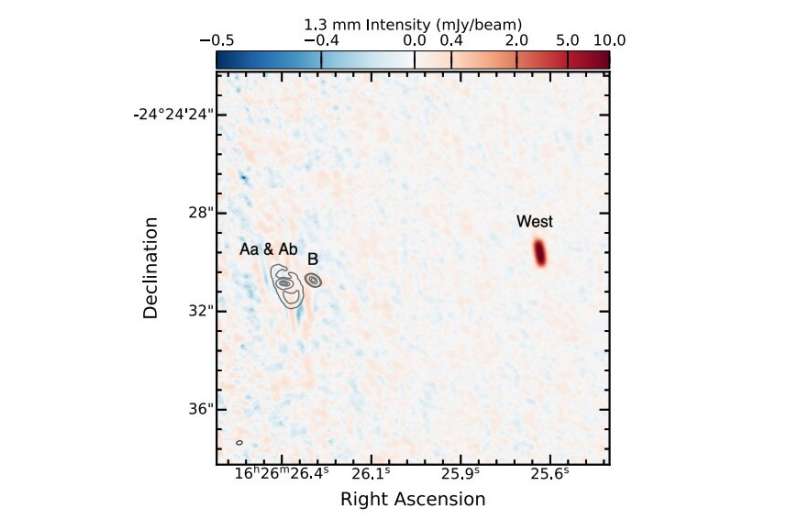September 26, 2022 report
VLA 1623 West is a young protostellar disk, study suggests

Astronomers from the Queen's University in Kingston, Canada and elsewhere, have used the Atacama Large Millimeter/submillimeter Array (ALMA) to observe a mysterious source known as VLA 1623 West. Results of the study, published September 14 on arXiv.org, shed more light on the properties of this source, suggesting that it is a young protostellar disk.
Protostellar disks are accretion disks around newborn stars, continuously delivering gas into protostars from the environment. Studies of these disks could be crucial in order to better describe the initial conditions and subsequently the dust evolution leading to planet formation.
VLA 1623 is one of the youngest protostar systems, located in the Rho Ophiuchi cloud complex, some 453 light years away. It is a hierarchical system consisting of potentially four separate objects, most likely protostars: a very tight protobinary VLA 1623Aa and VLA 1623Ab linked to another companion VLA 1623B, as well as VLA 1623 West. The nature of VLA 1623 West is still uncertain, however it has been suggested that it is composed of cloudlets of heated material at the edge of the outflow cavity wall.
Now, a team of astronomers led by Arnaud Michel has performed deep ALMA 1.3 and 0.87 millimeter observations of VLA 1623 West (or VLA 1623W for short) to constrain its shape and structure in order to better determine its origin.
"To study VLA 1623W, we use geometric models to fit sensitive Stokes I continuum ALMA observations at 0.87 and 1.3 mm taken from polarization data," the researchers wrote in the paper.
The analyzed models suggest that VLA 1623W is a protostellar disk, optically thick and flared. The astronomers found a global spectral index of approximately 1.5, consistent with a high dust optical depth across the disk and possibly lower than edge-on protoplanetary disks.
Further analysis of the results indicates that VLA 1623W is a young, highly-inclined protostellar disk. Its emission was found to be relatively constant along the major axis and not peaked.
According to the study, various models reveal similar positive residuals at the four corners of the disk at both observed wavelengths (0.87 and 1.3 mm). The researchers assume that these residuals are evidence that the disk is flared in the millimeter dust and that the flaring is mainly restricted to the disk's outer regions.
"Thus, VLA 1623W may represent a young protostellar disk where the large dust grains have not yet had enough time to settle into the mid-plane," the researchers explained.
The authors of the paper added that further observations of VLA 1623W at millimeter wavelengths are required in order to confirm the disk flaring. If this is confirmed, it will make VLA 1623W an interesting laboratory to study dust settling as well as dust grain properties across the vertical disk scale height in protostellar sources.
More information: Arnaud Michel, Sarah I. Sadavoy, Patrick D. Sheehan, Leslie W. Looney, Erin G. Cox, A millimeter-multiwavelength continuum study of VLA 1623 West. arXiv:2209.06781v1 [astro-ph.EP], arxiv.org/abs/2209.06781
© 2022 Science X Network





















